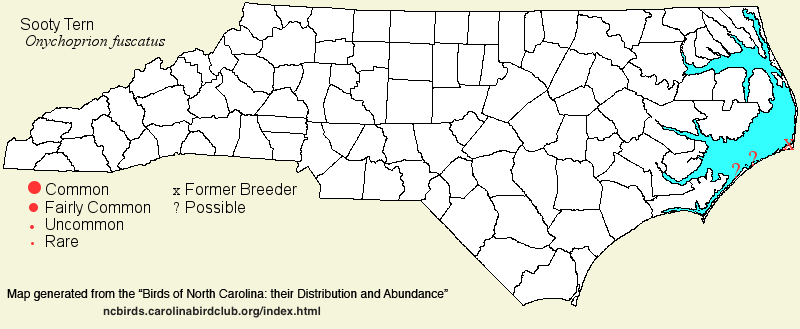 |  |
|
Sooty Tern - Onychoprion fuscatus LARIDAE Members: | Search Common: Search Scientific: |
|
|
|||||||
| General Comments | The Sooty Tern is sometimes considered to be the most abundant bird in the world, it being found commonly in tropical waters around the globe. Until recently included in the large genus Sterna, this species and the closely related Bridled Tern were moved into a separate genus in 2008. This graceful-flying tern is usually found in small numbers on most warm-season pelagic trips to the Gulf Stream in North Carolina waters -- at least from Jul into Sep, and it is one of the more frequent hurricane "victims", as numbers are displaced northward or inland by such storms. Interestingly, a few pairs of Sooty Terns have nested on North Carolina islands with other terns in the past few decades, though there appear to be no state breeding records since about 1997. Sooty Terns practically never rest on the ocean or on flotsam (as does the Bridled Tern), and thus they sleep in the air, while soaring. | ||||||
| Breeding Status | Sporadic Breeder | ||||||
| NC BRC List | Definitive | ||||||
| State Status | W | ||||||
| U.S. Status | |||||||
| State Rank | SHB,S3N | ||||||
| Global Rank | G5 | ||||||
| Coastal Plain | Mainly a pelagic visitor in the warmer seasons, but a sporadic breeder (at least formerly). Mostly an uncommon to fairly common offshore visitor and migrant in the warmer months, peaking in Aug and Sep; very rarely seen from shore, except when breeding, or after hurricanes/tropical storms. Large numbers have been seen along the coast after a few such storms, such as Hurricane David in 1979 and Hurricane Emily in 1993. Has bred at Morgan Island near Cape Lookout in 1978, Cape Hatteras in 1985, Shackleford Banks in 1995, and likely at other sites. There are a few Tidewater zone records, including an excellent 17 at the American Turf farm near Creswell, 3 Sep 2016. There are about ten far inland records -- 2, Mount Olive (Wayne), 17 Aug 1955 (after Hurricane Connie); 1, Goldsboro, 22 Sep 1989 (after Hurricane Hugo); 2, Lake Auman (Moore), 6-7 Sep 1996 (after Hurricane Fran); 3, Greenville, 27 Aug 1998 (after Hurricane Bonnie); 3, Goldsboro, 1 Sep 2006 (after Tropical Storm Ernesto); 2, Buckhorn Reservoir (Wilson), 1 Sep 2006 (after Ernesto); 3, Buckhorn Reservoir, 6 Sep 2008 (after Hurricane Hanna); 2, Buckhorn Reservoir, 3 Sep 2016 (after Tropical Storm Hermine); 10 at Lake Waccamaw (Columbus) and 2 at Tarboro (Edgecombe), 4 Aug 2020 (after Hurricane Isaias). Main occurrence period is late Apr to the end of Sep; one on 2 Nov 1979, seen offshore, is very late. Two adults were photographed far off Dare on the very early date on 31 Mar 2025. Peak counts: 668, offshore zone, between 5-10 Sep 1979 (after Hurricane David); 200, off Hatteras Inlet, 1 Sep 2024; 188, off Oregon Inlet, 29 Aug 2024; 164, off Hatteras, 7 Aug 1999 (apparently not storm-related); 159, offshore zone, 27 Aug 1979 (just before Hurricane David). A count of 8 seen from Jennette's Pier in Nags Head (Dare) on 1 Sep 2022 was notable for not being associated with a tropical storm. | ||||||
| Piedmont | Storm-carried visitor to the eastern portion of the province, plus three records for the southern portion. Very rare, with about 22 records for the province. Just three known records (surprisingly) for the lakes in the Triad area (none as yet) or for Lake Norman (three) -- one at Lake Norman from 12-14 Sep 2017 after Hurricane Irma, one there on 17 Sep 2018 after Hurricane Florence, and five there on 27 Sep 2024 after Hurricane Helene. All records from early Aug to late Sep, except for one record from Wake, of a specimen after a storm, on 30 Jun 1909. Peak counts: 5, Lake Norman, 27 Sep 2024; 3, Falls Lake, 6-7 Sep 1996 (after Hurricane Fran); 3, Jordan Lake, 22 Sep 1989 (after Hurricane Hugo); 3, Jordan Lake, 27 Aug 1998 (after Hurricane Bonnie); 3, University Lake in Chapel Hill, 27 Aug 2011 (after Hurricane Irene). | ||||||
| Mountains | Casual storm-carried visitor. All but one record (of different birds?) came after the passage of Hurricane Irma: singles at Hooper Lane (Henderson), 12-13 Sep 2017*, and at Lake Julian (Buncombe), 12 Sep 2017 [Chat 82:37 link], [Chat 82:57 link]. The NC BRC reviewed and accepted the first record; the second perhaps will not be reviewed. Also, an immature was seen at Lake Julian on 16 Sep 2018, following the passage of Hurricane Florence [Chat 83:28 link]. | ||||||
| Finding Tips |
Offshore, this species is normally less numerous than the Bridled Tern. The best times to look for them are from late Jul to mid-Sep. If a hurricane is headed for the mainland, it is a good idea to check reservoirs close to the path of the eye (but driving to the reservoir in the daytime and with great care, as often there are trees, limbs, or electric wires in the roads!); the Sooty Tern can often be found for a few hours or a day following the storm passage. ** | ||||||
| Attribution | LeGrand[2025-07-24], LeGrand[2025-01-30], LeGrand[2023-03-18] | ||||||
| NC Map Map depicts all counties with a report (transient or resident) for the species. | Click on county for list of all known species. |
| NC Breeding Season Map Map depicts assumed breeding season abundance for the species. |  |